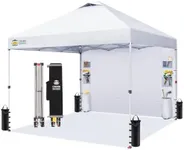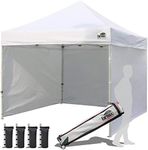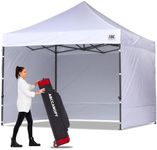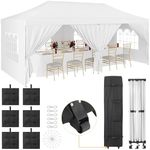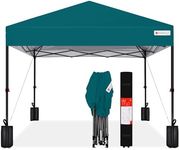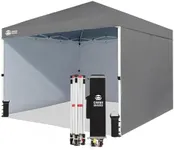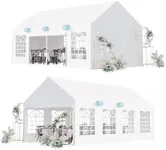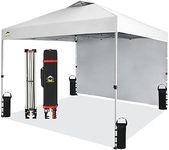Buying Guide for the Best Pop Up Canopy With Sides
Choosing the right pop-up canopy with sides can make a significant difference in your outdoor events, whether it's for a market stall, a family gathering, or a camping trip. The right canopy will provide shelter from the elements, offer privacy, and create a comfortable space. To make an informed decision, you need to consider several key specifications that will determine the canopy's suitability for your needs.SizeThe size of the canopy is crucial as it determines the amount of space you will have under the shelter. Canopies come in various sizes, typically ranging from 8x8 feet to 10x20 feet. Smaller canopies (8x8 feet) are suitable for intimate gatherings or small market stalls, while larger ones (10x20 feet) are ideal for bigger events or when you need more covered space. Consider the number of people and the amount of equipment or furniture you need to accommodate when choosing the size.
MaterialThe material of the canopy and its sides affects durability, weather resistance, and overall performance. Common materials include polyester and polyethylene. Polyester is lightweight, water-resistant, and offers good UV protection, making it suitable for general use. Polyethylene is more durable and waterproof, ideal for harsher weather conditions. If you plan to use the canopy frequently or in varying weather, opt for a more durable material.
FrameThe frame of the canopy provides structural support and stability. Frames are typically made from steel or aluminum. Steel frames are strong and durable but heavier, making them less portable. Aluminum frames are lighter and more resistant to rust, making them easier to transport and ideal for frequent setup and takedown. Choose a frame based on your need for portability versus durability.
Ease of SetupThe ease of setup is important, especially if you plan to assemble the canopy by yourself or frequently move it. Look for canopies with a pop-up design that allows for quick and easy setup without the need for tools. Some models come with features like push-button sliders and telescoping legs that simplify the process. If you value convenience and time-saving, prioritize canopies that are user-friendly and easy to set up.
Weather ResistanceWeather resistance is a key factor, especially if you plan to use the canopy in different weather conditions. Look for canopies with water-resistant or waterproof materials and UV protection to shield against rain and sun. Some canopies also come with wind-resistant features like reinforced frames and tie-downs. Consider the typical weather conditions in your area and choose a canopy that offers adequate protection.
VentilationVentilation is important for maintaining comfort inside the canopy, especially in hot weather. Some canopies come with built-in vents or mesh windows that allow for airflow while keeping insects out. If you plan to use the canopy in warm climates or for extended periods, look for models with good ventilation features to ensure a comfortable environment.
PortabilityPortability is a consideration if you need to transport the canopy frequently. Look for canopies that come with a carrying case or bag for easy transport. Lightweight materials and compact designs also enhance portability. If you need to move the canopy often, prioritize models that are easy to carry and store.
SidewallsSidewalls provide additional protection and privacy. They can be solid, mesh, or have windows. Solid sidewalls offer maximum privacy and protection from wind and rain, while mesh sidewalls provide ventilation and keep insects out. Sidewalls with windows allow light in while maintaining some level of privacy. Consider your need for privacy, protection, and ventilation when choosing the type of sidewalls.


